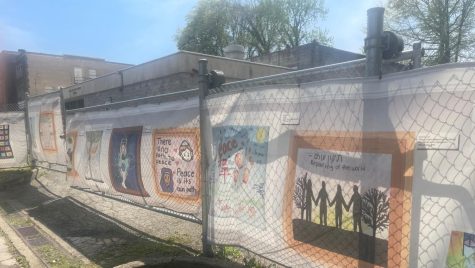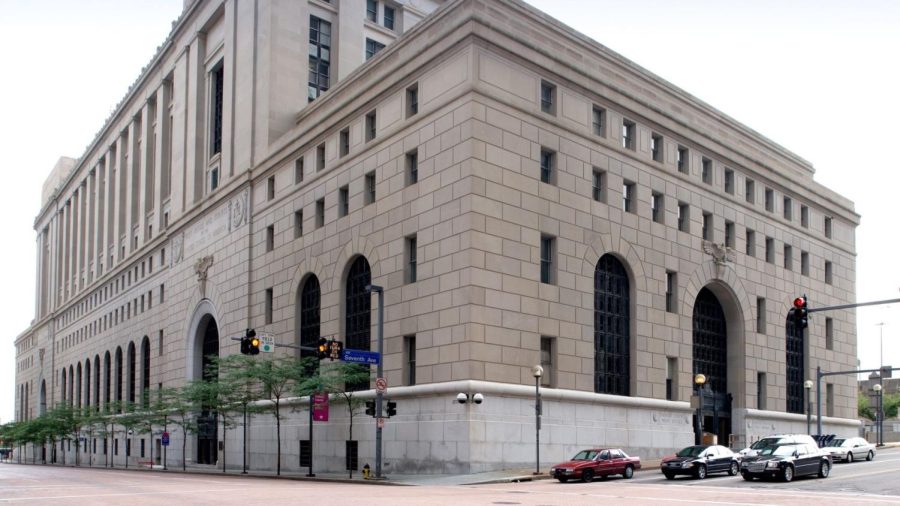911 dispatcher and rabbi take the stand on first day of Pittsburgh synagogue shooting trial
U.S. Courthouse and Post Office, Pittsburgh, Pennsylvania. Nov. 16, 2010. (Carol M. Highsmith/Buyenlarge/Getty Images)
Published May 30, 2023
PITTSBURGH (JTA) — When Shannon Basa-Sabol was asked to recount the events of the Pittsburgh synagogue shooting in court on Tuesday, what stood out was her memory of the death of Bernice Simon.
Basa-Sabol, a 911 dispatcher, took the stand for close to an hour, describing the ins and outs of her job.
But when the crowded courtroom heard a recording of Simon’s 911 call from the Tree of Life Congregation, Basa-Sabol paused and began to sniffle. She described telling Simon to stay quiet, then hearing multiple gunshots over the phone.
“Are you still with me?” Basa-Sabol said on the recording of the call. “Bernice, can you hear me?”
Speaking on the witness stand on Tuesday, Basa-Sabol said she had realized Simon no longer had “sufficient breathing for life.”
“I was hearing her being shot,” she said.
Basa-Sabol was the first witness in the trial of Robert Bowers, the man accused of murdering 11 Jews in their Pittsburgh synagogue on Oct. 27, 2018. For months, survivors, relatives of victims and the Jewish community of Pittsburgh have anticipated the trial, which began Tuesday, hoping for closure while worrying that the proceedings would retraumatize people, even as no one doubted the culpability of the accused.

As the prosecution and defense gave their opening statements, it was clear that the trial would air graphic details from the attack. But while lawyers and witnesses recounted the events of the day, the courthouse was also the scene of embraces, tears of comfort, discussions of Jewish tradition and even laughter as those who lived through the tragedy connected with and supported one another.
Families of victims and survivors were in the courtroom and monitoring via videolink elsewhere in the Joseph Weis Federal Courthouse in downtown Pittsburgh. Social workers and psychologists were on hand to help them through the proceedings. Reporters were asked not to conduct interviews in the building.
At a break, Tim Matson, a policeman injured in an exchange of fire with the suspect, sought out Andrea Wedner, who was shot and whose mother, Rose Mallinger, was killed. They hugged.
Maggie Feinstein, the director of the 10/27 Healing Partnership, which provides post-traumatic therapy for the community, watched closely over the nine or so family members in the courtroom, and handed them tissues.
“Today marked the beginning of a very difficult and painful trial that is the direct result of an incredibly terrible action by one person,” Feinstein wrote in an email after the court was adjourned. “It represented an important step in the process of justice, because these court proceedings are a way for our society to take up the burden of remembering and telling the truth about what happened on October 27, 2018.”
On the witness stand, Jeffrey Myers, the rabbi of Tree of Life Congregation, cried as he described how he recited the Shema, thinking he was about to die.
“I thought about the history of my people, how we’ve been persecuted and hunted and slaughtered for centuries,” he said. “And about how all of them must have felt in the moments before their death, and what they did was recite Deuteronomy, chapter 6, verse 4, ‘Hear, O, Israel, the Lord is our God, the Lord is One.”
The defendant is accused of murdering 11 people and wounding six at three congregations that met in the same building — Tree of Life, Or L’Simcha and Dor Hadash. He faces 63 charges, 22 of which are death penalty charges that relate specifically to allegations that he targeted Jews: 11 counts of obstruction in free exercise of religious belief resulting in death, and 11 counts of hate crimes resulting in death. Prosecutors previously rejected a guilty plea so that they could pursue the death penalty — a punishment that families of victims and congregational leaders have debated.
Jury selection began last month and took three weeks, culminating in the selection of 18 jurors and alternates — 11 men and seven women.
In their opening statements, prosecutors and defense lawyers alike warned that the trial would revisit the attack in horrific detail. Judge Robert Colville emphasized the presumption of innocence, telling the jury that Bowers had a “clean slate” unless the prosecution was able to persuade them otherwise.
He warned jurors to avoid reading about the case in the media, and not to discuss it with friends or even with each other. And he added what he acknowledged was a recent and novel caution: “Persons, entities or even foreign governments may seek to manipulate your opinions,” instructing them not to click through if they saw messages relating to the trial popping up on their computer.
Assistant U.S. Attorney Song Soo’s 31-minute statement, delivered in a steady tone that only occasionally fluttered with emotion, set forth her case in vivid terms: A community that had come together for decades in love and caring for each other, and for Jewish tradition, was shattered by a gunman determined to murder Jews.
“In the Tree of Life synagogue, the words ‘Tree of Life’ are written in Hebrew high above the bookstand that holds the Torah, the holiest book in the Jewish faith,” she said. “The Tree of Life synagogue had anchored the corner of Wilkins and Shady for decades. As they did every Saturday men and women of the Jewish faith made their way to the synagogue to observe Shabbat.”
She noted that the Torah portion that week, Vayera, “was from the Book of Genesis and was about welcoming strangers.” She went on to describe the warmth of those who were killed and dwelled on Cecil and David Rosenthal, men in their 50s with developmental disabilities who loved to greet congregants.
“In many ways, they were like children, childlike because of their mental disabilities, trusting and pure,” Soo said, adding that fellow congregants would help them “tie a shoe lace, tuck in a shirt, find a page in a prayer book.”
“That morning David Rosenthal stood at the front of the chapel helping to lead the opening prayer” he had memorized, she said. “His devotion to the faith made up for the fact that he could not actually read the prayer book.”
Then, she described the carnage, referring to the defendant’s alleged statements of hate on Gab, a social media platform friendly to right-wing extremists. He allegedly condemned HIAS, the Jewish refugee aid group that partnered with Dor Hadash.
“That same morning the defendant was making his own preparations to destroy, to kill and defile,” Soo said. “He hated Jews, he called them ‘the children of Satan … the most bloodthirsty, evil demons who ever walked the face of the earth.’”
She read out the Gab entry Bowers allegedly posted while he was parked outside the synagogue complex. “HIAS likes to bring in invaders that like to kill our people. I can’t sit by and watch our people get slaughtered, screw your optics, I’m going in.”
“And the defendant did go in,” Soo said. She described some of the congregants’ deaths in detail, and concluded by reading out the 11 names of the murdered: Cecil and David Rosenthal, couple Bernice and Sylvan Simon, Rose Malinger, Joyce Fienberg, Richard Gottfried, Jerry Rabinowitz, Daniel Stein, Melvin Wax and Irving Younger.
The defendant, clad in a green sweater over an open-collared light blue shirt, stared ahead and scribbled notes. He never looked at Soo, who spoke at a podium to his right.
In her opening statement, Bowers’ lead attorney, Judy Clarke, said the defense would not contest the events, or Bowers’ responsibility for them. Clarke is known as “the attorney for the damned” for her determination to keep her clients from execution. She has defended the Unabomber, the Boston Marathon bomber and one of the conspirators who planned the 9/11 attacks.
“This senseless act, the loss and devastation, were caused by Robert Bowers,” she said. “There is no disagreement, there is no dispute and there will be no doubt as to who shot the 11 congregants. On Oct. 27, 2018, Robert Bowers, the man seated at that table, loaded with ammunition and firearms entered the synagogue.”
Clarke suggested that her defense would focus on whether the defendant’s motives met the standards required by the government’s charges, particularly regarding the 22 death penalty charges.
“We can at least do our best to uphold the rule of law by figuring out, to the best of our ability, what were Mr. Bowers’ motives and intent,” she said. She argued that her client’s statements, which focused on his deluded belief that Jews were intent on replacing white people, do not make clear that his intent met the standards enshrined in federal law.
“These statements are outrageous,” she said. “The fact that they were made raises more questions than they may answer.”
Carol Janssen, another employee from a 911 call center, testified, and in the afternoon, for a number of hours, Eric Olshan, a Jewish U.S. Attorney, asked Myers to guide the jurors through a tour of a physical scale model of the synagogue that was brought into the courtroom. Myers described the building, its congregations and the fundamentals of Judaism to an attentive jury.
Shabbat ends “when three stars are in the sky,” said Myers, who wore a black suit and white kippah and delivered his testimony in measured tones. He wore a kippah because “it reminds me that I’m in God’s presence wherever I go.”
Myers occasionally smiled at the jury when he cracked a joke, eliciting laughter, as when he recalled what a SWAT team advised him when they reached him in the synagogue: “Rabbi, run your ass off.”
And, as the defendant stared at him, Myers memorialized his murdered congregants, affectionately recalling their self-appointed roles during Sabbath services. He remembered one of the victims, Cecil Rosenthal, who always beat him to the synagogue so he could be in place to greet all comers. “I would say to him jokingly, ‘Cecil did you sleep here again?’”
David Rosenthal, he said, sang prayers “loudly,” while Rose Mallinger routinely led the prayer for peace, “that all people can live together in freedom and peace.”
As he recalled the moments of the shooting, Myers said, he felt he would not be angry at God, “because it was not God who did this. I was prepared to meet my fate.” He sobbed.
The scheduled Torah reading from Genesis 12, he said, narrates how Abraham welcomes three strangers.
“I was going to talk about the Jewish imperative to welcome all guests whoever they may be,” he said. “But I never gave that sermon.”
The defense declined to cross-examine the rabbi.
—
The post 911 dispatcher and rabbi take the stand on first day of Pittsburgh synagogue shooting trial appeared first on Jewish Telegraphic Agency.















